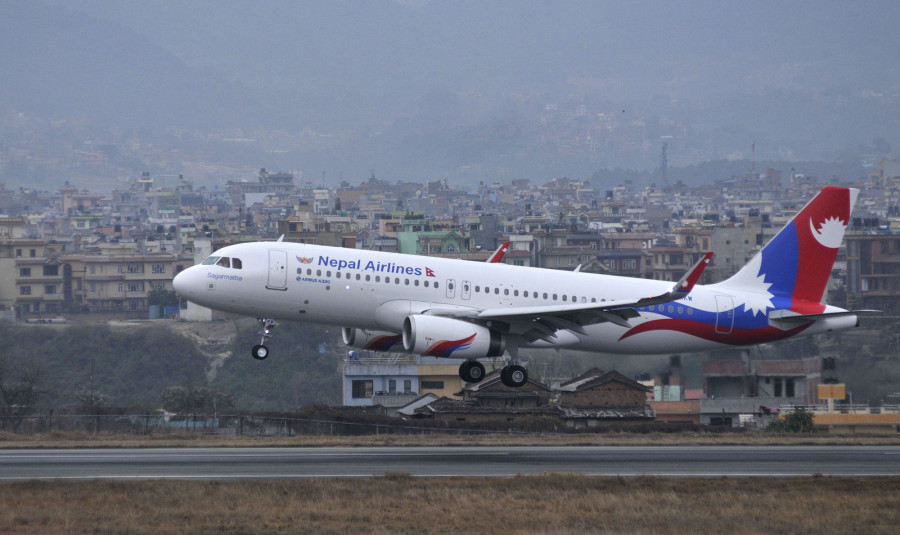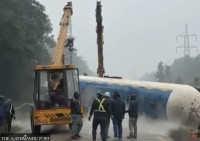National
Nepal shuts all international flights save two a week between Kathmandu and Delhi
Officials fail to explain why, but questions have arisen over the decision as virus cases have been surging in the capitals of both Nepal and India.
Sangam Prasain
While all international scheduled flights connecting Kathmandu have been ordered to halt from Thursday midnight until May 14, the government has decided to allow as many as two flights a week on the Kathmandu-Delhi sector, the two capitals, which have emerged as coronavirus hotspots.
Nepali authorities have been struggling to contain the rapid rise of virus cases as experts fear that tens of thousands of people may have caught the more contagious new variants emerging out of Nepal’s immediate neighbour, India.
Following Sunday's Cabinet decision to halt all international and domestic flights, which had caused confusion among travellers, the Civil Aviation Authority of Nepal on Monday issued a statement in what appeared to be a bid to make things clear.
“There shall be only two flights a week [one flight each by Nepal Airlines and Air India] under the air bubble arrangement between Nepal and India effective from May 6 midnight to May 14,” reads the statement by the country’s civil aviation regulator.
The aviation body said that arriving passengers shall undergo mandatory quarantine at their own cost for 10 days in hotels designated by the Tourism Ministry.
Passengers are required to furnish PCR report with photo identification upon their arrival at Kathmandu’s Tribhuvan International Airport.
“Any airline found boarding any PCR positive passenger shall be liable to bear the cost of hotel quarantine of all passengers onboard the aircraft,” reads the statement.
The KP Sharma Oli administration’s reluctance to make public Cabinet decisions these days often tend to create confusion among the members of the public. At times, even ministers don’t know of many decisions.
On Sunday, when the Cabinet took a slew of decisions, journalists had no option than to call ministers present in the meeting. Bhanubhakta Dhakal, the tourism minister, who should have been in the know of the decision regarding flights, however, was not present in the meeting because he was isolating himself at home after catching Covid-19.
“I have been self-isolating at home,” Dhakal told the Post on Sunday evening.
At least two other ministers the Post spoke to, however, said all (international) commercials flights would be suspended from Wednesday midnight.
Officials at the civil aviation authority refused to comment saying they had not seen the Cabinet decision.
The Post on Sunday evening reported that all domestic flights and all international flights would be suspended from Monday midnight and Wednesday (May 5) midnight, respectively. The Post also reported that charter flights—flights that are not part of an airline's published schedule—would be allowed.
But on Monday, Prime MInister Oli, during his address to the nation, said that all international flights would be suspended effective Thursday (May 6) midnight.
But soon after, the Civil Aviation Authority of Nepal issued a statement regarding international flights to Kathmandu, in which it talked about two flights a week on the Kathmandu-Delhi sector.
The decision surprised many, as they questioned why Delhi was kept on an exceptional list.
“Can someone, anyone, explain to me, [sic] the logic behind Nepal Government's decision to stop all flights OUT [sic] of country (except Delhi, btw) ? Incoming, OK, understood. But outgoing? What about those that need to leave the country? Syndicated high priced charter flights?” questioned Sameer Mani Dixit, director of research of Center for Molecular Dynamics Nepal, a tweet.
Most of the countries in the world have already suspended flights from Delhi in the wake of the rising number of coronavirus cases.
India has been hit hard by a second wave of the coronavirus, and the country has been clocking more than 350,000 new infections lately. Earlier this week, India became the first country to ever report 400,000 new infections a day.
Nepal is no different. When it comes to new daily infections per million people, Nepal is not far behind India, according to the Our World in Data.
At least three government officials the Post spoke to said they don’t know why two flights between Kathmandu and Delhi have been allowed.
“The objective of the flight ban was purely to control the spread of the coronavirus, particularly from India. But it seems Nepal wants to be in India’s good books as the country itself is facing a tough time,” said an official at the Civil Aviation Authority of Nepal requesting anonymity because he feared getting embroiled in controversy. “Most of the countries have started to cut connectivity with the South Asian giant.”
When the coronavirus cases were rising in early April and thousands of Nepali migrant workers started to return from India, the Oli administration paid little attention to management of border points.
People entering without testing and without being kept in quarantine and isolation centres is said to be one of the reasons for the virus making an easy entry into Nepal.
Until a few weeks ago, many Indians were making Kathmandu their transit to fly to the Gulf countries. After experiencing a surge in the number of its citizens seeking no objection certificates to fly to third countries via Nepal, the Indian embassy even scrapped the provision of the no objection certificates.
Multiple officials either did not respond or did not want to discuss why the Oli government has allowed two flights between Kathmandu and Delhi despite growing calls to completely shut commercial flights.
Some insitunauted political reasons but they would not elaborate.
Ever since Oli was driven into a minority in his then Nepal Communist Party (NCP) last year, he has tilted towards the south. Oli made some visible efforts in the last quarter of last year to strike a rapprochement with New Delhi.
But whether the decision to keep two flights intact between Delhi and Kathmandu stems solely from Oli’s part of his policy to appease the southern neighbor was not immediately known.
All domestic flights in Nepal, however, have been halted from Monday midnight.
Nepal on Monday reported the highest single-day toll of 37 Covid-19-related deaths and another record daily surge of coronavirus cases as the country recorded more than 7,000 new infections for two consecutive days.
The country recorded 7,388 new cases in polymerase chain reaction tests and 60 antigen positives. The death toll now stands at 3,362. The Kathmandu Valley recorded 3,666 new infections in the past 24 hours. Of them, 2,922 cases were confirmed in Kathmandu, 522 in Lalitpur and 222 in Bhaktapur.
The countrywide infection tally has reached 343,418, with the number of active cases at 54,041.
According to Reuters, India’s tally of coronavirus infections rose on Monday to just short of 20 million, propelled by a 12th straight day of more than 300,000 new cases, as scientists predicted the pandemic could peak in the next couple of days.
Total infections since the start of the pandemic have reached 19.93 million, swelled by 368,147 new cases over the past 24 hours, while the death toll rose by 3,417 to 218,959, health ministry data show. At least 3.4 million people are currently being treated.
Rajan Pokhrel, director general of the Civil Aviation Authority of Nepal, said two flights have been opened on the Kathmandu-Delhi sector in view of emergency measures.
“The government may have thought about keeping the air bubble arrangement open so that if, in case, any event unfolds, it can get help from the neighbour,” Pokhrel told the Post. “But passengers coming from New Delhi are required to stay mandatorily in 10-day quarantine and that should not be a cause for concern,” he said.
Nepal joined India’s air bubble scheme in December last year after frequent requests from India, allowing a daily flight between two capitals on a reciprocal basis. Although all international flights, except China, started from September 1, India did not allow passenger flights.
In early October 2020, before the start of the Dashain festival, Nepal had decided to join India’s air bubble scheme in order to bring hundreds of Nepalis stranded in different parts of India.
It was first proposed by India’s civil aviation minister Hardeep Singh Puri in mid-August.
After necessary discussions, then tourism minister Yogesh Bhattarai had tabled the agenda on joining the air bubble scheme at the Covid-19 Crisis Management Centre meeting.
However, Bhattarai tested positive for the coronavirus on October 10 before any decision could be taken by the Cabinet meeting.
The proposal was then kept on hold by Prime Minister Oli as he said “let’s look for a few weeks before making the decision”, according to multiple sources familiar with the matter. Then the festival season started and the proposal never got the ministry’s attention.
But soon after, when Nepal and India’s souring relations started to normalise, the proposal got traction and the air bubble scheme was implemented.




 12.12°C Kathmandu
12.12°C Kathmandu













%20(1).jpg&w=300&height=200)

